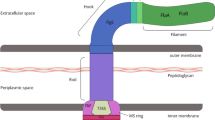Summary
Electronmicroscopic investigations of germinating conidia ofAspergillus nidulans reveal that inhibition of the microtubular-(MT)-assemblage is responsible for the antimitotic activity of methyl benzimidazol-2-ylcarbamate (MBC). 15 hours incubation with 4 μM MBC results in a sevenfold increase of the volume of the nucleus associated organelle (NAO). During this enlargement its discoidal entities (DE) are favoured in increasing length and width. The distance of both DEs however remains nearly uneffected.
In many cases, MBC-treatment leads to the formation of more than one NAO per nucleus (mainly two). They are distinctly smaller than the NAO of a nucleus with one NAO only. They can be arranged in couples or more distant on the nuclear envelope. The observed maximum of 4 NAO per nucleus is considered as a result of two completed replicationcycles. The development of the mitotic spindle remains inhibited in all cases. This indicates, that supplementary replication of the NAO is possible without nuclear division.
Zusammenfassung
Elektronenmikroskopische Untersuchungen keimender Konidien vonAspergillus nidulans zeigen, daß die antimitotische Aktivität von Methylbenzimidazol-2-ylcarbamat (MBC) auf eine Inhibierung der Mikrotubuli (MT)-Assemblierung zurückzuführen ist. 15stündige Einwirkung von 4 μM MBC führt zu einer durchschnittlich 7fachen Volumenzunahme des kernassoziierten Organells (NAO). Dabei werden bevorzugt das Längen- und Breitenwachstum der diskoiden Einheiten (DE) stimuliert. Der lichte DE-Abstand bleibt im Vergleich zur unbehandelten Kontrolle konstant und ebenso nimmt die Größe des Mittelteils (MP) in der entsprechenden Richtung nicht zu.
Bei zahlreichen MBC-behandelten Keimhyphen treten mehrere (vorwiegend 2) NAO/Kern auf. Sie sind deutlich kleiner als die Einzel-NAO nach MBC-Behandlung. Sie können paarweise oder weit voneinander entfernt auf der Kernhülle lokalisiert sein. Die nachgewiesenen 4 NAO/Kern werden als Folge von zwei abgeschlossenen Replikationszyklen angesehen. Die Entwicklung der Mitosespindel ist in jedem Falle inhibiert. Die Ergebnisse zeigen, daß NAO-Replikationen unabhängig von vollzogenen Kernteilungen erfolgen können.
Similar content being viewed by others
Abbreviations
- Chr :
-
Chromatin
- DE :
-
discoide Einheiten
- MP :
-
Mittelteil
- N :
-
Zellkern
- KH :
-
Kernhülle. 80 000 X
- Chr :
-
Chromatin
- DE :
-
discoide Einheiten
- MP :
-
Mittelteil
- N :
-
Zellkern
- KH :
-
Kernhülle
- Chr :
-
Chromatin
- DE :
-
discoide Einheit
- MP :
-
Mittelteil
- KH :
-
Kernhülle
Literatur
Bainbridge, B. W., 1971: Macromolecular composition and nuclear division during spore germination inAspergillus nidulans. J. gen. Microbiol.66, 319–325.
Bensch, K. G., andS. T. E. Malawista, 1969: Microtubular crystals in mamalian cells. J. Cell Biol.40, 95–107.
Bollen, G. J., andA. Fuchs, 1970: On the specificity of thein vitro andin vivo antifungal activity of benomyl. Neth. J. Pl. Path.76, 299–312.
Clemons, G. P., andD. H. Sisler 1971: Localization of the site of action of a fungitoxic benomyl derivative. Pestic. Biochem. Physiol.1, 32–43.
Damsky, C. H., W. M. Nelson, andA. Claude, 1969: Mitochondria in anaerobically-grown lipid limited Brewer's yeast. J. Cell Biol.43, 174–179.
Davidse, L. C., 1973: Antimitotic activity of methyl benzimidazol-2-yl-carbamate (MBC) inAspergillus nidulans. Pestic. Biochem. Physiol.3, 317–325.
—, 1975: Antimitotic activity of methyl benzimidazol-2-yl-carbamate in fungi and its binding to cellular protein. Microtubules and microtubuli inhibitors (Borgers, M., andde Brabander, eds.), pp. 483–495. Amsterdam: North-Holland Publ. Company.
Giles, K. W., andA. Myers, 1965: An improved diphenylamine method for the estimation of deoxyribonucleic acid. Nature206, 93.
Girbardt, M., 1968: Ultrastructure and dynamics of the moving nucleus. In: Aspects of cell motility. Cambridge: Univ. Press.
—, 1971: Ultrastructure of the fungal nucleus. II. The kinetochore equivalent (KCE). J. Cell Sci.9, 453–473.
—, undH. Hädrich, 1975: Ultrastruktur des Pilzkernes. III. Genese des Kern-assoziierten Organells (NAO=„KCE“). Z. allg. Mikrobiol.15, 157–173.
Hammerschlag, R. S., andH. D. Sisler, 1972: Differential action of benomyl and methyl-2-benzimidazolcarbamate (MBC) inSaccharomyces pastorianus. Pestic. Biochem. Physiol.2, 123–131.
Heath, I. B., 1974: Mitosis in the fungusThraustotheca clavata. J. Cell Biol.60, 204–220.
Künkel, W., 1972: Elektronenmikroskopische und physiologische Untersuchungen am Synchronsystem „Keimende Konidiospore vonAspergillus nidulans“. Dissertation.
—, 1974: Einfluß der Sporulation und der Kulturbedingungen auf die Kernteilungssynchronie keimender Konidien vonAspergillus nidulans. Z. Allg. Mikrobiol.14, 213–220.
Künkel, W., 1974: Ultrastruktur des Kern-assoziierten Körperchens („centriolar plaque“, „MTOC“, „KCE“) während der Interphase in der Konidie vonAspergillus nidulans. Z. allg. Mikrobiol.14, 53–61.
Lee, J. C., 1973: The chemical characterization of calf brain microtubule protein subunits. J. biol. Chem.248, 7253–7262.
Lu, B. C., andN. B. Raju, 1970: Meiosis inCoprinus. II. Chromosome pairing and the Lampbrush diplotene stage of meiotic prophase. Chromosoma (Berl.)29, 305–316.
Moreau, F., 1958: Les progrès récents de la cytologie de champignons en microscopie usuelle et en microscopie corpusculaire. Bull. Soc. Bot. Fr.105, 363–429.
Pickett-Heaps, J. D., 1969: The evolution of the mitotic apparatus: an attempt at comparative ultrastructural cytology in dividing plant cells. Cytobios3, 257–280.
Reynolds, E. S., 1963: The use of lead citrate at high pH as an electron-opaque stain in electron microscopy. J. Cell Biol.17, 208–212.
Richmond, D. V., andR. J. Pring, 1971: The effect of benomyl on the fine structure ofBotrytis fabae. J. gen. Microbiol.66, 79–94.
Ris, H., andD. F. Kubai, 1974: An unusual mitotic mechanism in the parasitic protozoanSyndinium sp. J. Cell Biol.60, 702–720.
Robinow, C. F., andC. E. Caten, 1969: Mitosis inAspergillus nidulans. J. Cell Sci.5, 403–431.
Rosenberger, R. F., andM. Kessel, 1967: Synchrony of nuclear replication in individual hyphae ofAspergillus nidulans. J. Bacteriol.94, 1464–1469.
Sentein, P. etY. Ates, 1975: Le mécanisme du blocage de la centrosphère par des substances semblables à la quinoline. Bull. Ass. Anatom.165, 505–522.
Strassburger, J., undH. Müller, 1976: Streulichtuntersuchungen zur Assemblierung von mikrotubulärem Protein. Ergeb. exp. Med.24, 207–210.
Westergaard, M., andD. von Wettstein, 1970: The nucleolar cycle in an ascomycete. C. R. Lab. Carlsberg37, 195–237.
Author information
Authors and Affiliations
Rights and permissions
About this article
Cite this article
Künkel, W., Hädrich, H. Ultrastrukturelle Untersuchungen zur antimitotischen Aktivität von Methylbenzimidazol-2-ylcarbamat (MBC) und seinen Einfluß auf die Replikation des Kern-assoziierten Organells (“centriolar plaque”, “MTOC”, “KCE”) beiAspergillus nidulans . Protoplasma 92, 311–323 (1977). https://doi.org/10.1007/BF01279467
Received:
Issue Date:
DOI: https://doi.org/10.1007/BF01279467




